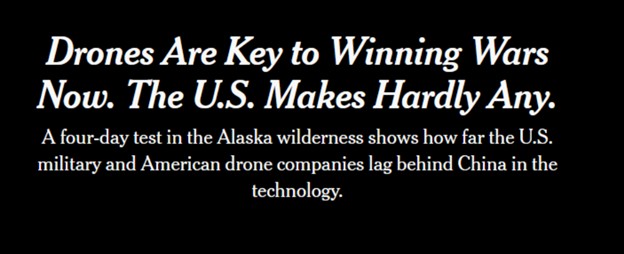How socionomics predicted the rise of “belligerence-on-the-cheap”
The July 13 New York Times addressed a growing disadvantage of the world’s most powerful military force: a lack in drone making and proficiency. From the article:

The journalist witnessed a series of failed training exercises: UA’s missing targets, nose-diving, and crashing into mountains and writes:
These drones weren’t flown by amateur hobbyists. They were launched by drone manufacturers paid by a special unit of the Department of Defense as part of an urgent effort to update U.S. capabilities.
The nation lags behind Russia and China in manufacturing drones, training soldiers to use them and defending against them, according to interviews with more than a dozen U.S. military officials and drone industry experts.
Over a decade ago, our February 2012 Socionomistpredicted that negative social mood would cause a radical shift in the way future wars were fought… and won. We said:
As animosity rises and military budgets fall, expect even more belligerence-on-the-cheap. Verbal threats, espionage, trade wars, financial conflicts, internal terrorism, cyberattacks, authoritarian clashes, border conflicts, drone attacks and anti-satellite attacks should all increase.
Advances in military technology increasingly reduce the costs of monitoring and controlling people… All told, two thirds of worldwide investment in unmanned planes in 2010 will be spent by countries other than the United States.
We acknowledged the U.S. falling behind the drone-making curve then. Now, the July 13 New York Times emphasizes that the time to play catch up is behind us, quoting an expert in the field:
Do we need a capability like this? Yes. I think that is very clear in the modern battlefield… Things haven’t gone as smoothly as I wanted. It’s clear that there are some still really hard technological challenges to overcome.
We all know the same thing. We aren’t giving the American war fighter what they need to survive warfare today.
Our July 2025 Socionomist cover story “Cheap Weapons: Negative Mood and the Changing Nature of War” updates our analysis and provides invaluable insights into how to successfully navigate the evolving landscape of military technologies.
